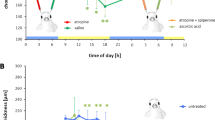Abstract
To clarify further the functional anatomy of the avian choroid, including its innervation, 12 adult White-Leghorn chickens were studied by standard electron microscopy and immunoelectron microscopy with somatostatin antibody. The endothelial cells of the blood vessels in the choriocapillaris have fenestrations only facing the retina, while the nuclei are situated toward the sclera. In addition to tight junctions and zonulae adherentes, adjoining endothelial cells form gap junctions and dense plaques with attached filaments resembling those of smooth muscle cells. The fine structure of arteries and veins is similar to that of the vasculature described in other organs. The supporting tissue is organized in trabeculae, i.e., bridges of cellular and fibrous elements that surround and sustain blood and lymphatic vessels. This tissue consists primarily of a system of fusiform or star-shaped smooth muscle cells, connected to each other and to those in the vessels’ walls through macular junctions of the adherent type, less prominent than desmosomes, and perhaps also punctiform gap junctions. Occasionally, trabecular smooth muscle cells approach the lymphatic vessels, which lack a muscular tunica, and abut their endothelium with spinous appendages. This stromal muscle tissue may act as a pump for moving the lymph. The suprachoroidea consists of large lymphatic lacunae and the multilayered membrana fusca. The elongated fuscal cells form adherent junctions, tight junctions, and perhaps also gap junctions, suggesting that the membrana fusca exerts complex functions. Nerves containing myelinated axons reach the choroid and divide into smaller branches, a few of which innervate the membrana fusca. Numerous, thin nerve branches reach both the walls of arteries and veins and the trabeculae, and synaptic terminals abut the outer muscular layers of the vessel’s wall and the smooth muscle cells of the supporting tissue. Immunocytochemistry reveals the presence of numerous somatostatin-positive and somatostatin-negative axons and synaptic terminals within both trabeculae and vascular tunica media. The somatostatin-positive axons are presumed to be cholinergic axons of the choroid neurons residing in the ciliary ganglion. Taken together, these observations indicate that the avian choroid is a highly vascularized muscular sheath that may be endowed with degrees of motility and elasticity higher than those of the mammalian choroid and may therefore play an important role in compensation for experimental defocus.
Similar content being viewed by others
Author information
Authors and Affiliations
Additional information
Accepted: 21 January 1997
Rights and permissions
About this article
Cite this article
De Stefano, M., Mugnaini, E. Fine structure of the choroidal coat of the avian eye . Anat Embryol 195, 393–418 (1997). https://doi.org/10.1007/s004290050060
Issue Date:
DOI: https://doi.org/10.1007/s004290050060



